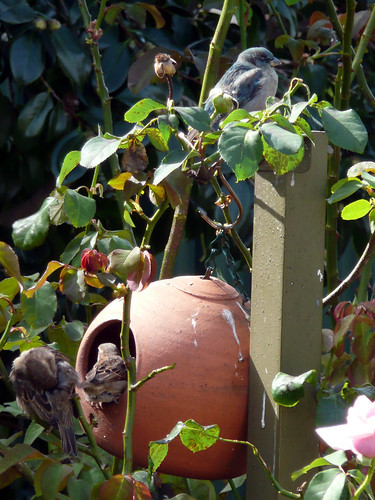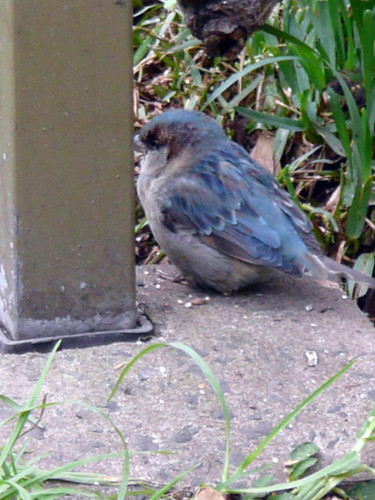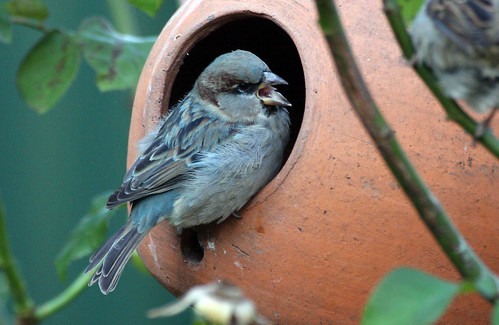tags: Blue House Sparrow, Passer domesticus, birds, blue feather color, plumage color, refraction
Blue-colored Male House Sparrow, Passer domesticus,
photographed in Sydney, Australia, April 2009.
Image: Richard Shears, Daily Mail [larger view].
Some of you might remember the remarkable photographs of the blue-colored male house sparrow, Passer domesticus, that was photographed in a garden in Sydney, Australia a couple weeks ago. I posted the images I had, along with my speculations, but was unable to go further than that. However, I tracked down the photographer and he has very kindly written back, and included more images and comments for us to speculate over.
Dear GrrlScientist (Sorry, I don't know who you are),
Thank you for your very interesting observations about 'my' blue sparrow recently.
I'm a writer with London's Daily Mail newspaper, based in Sydney, Australia, and I suppose many people would have thought 'Oh, he's a journalist - how come a blue sparrow happens to land in his garden?'
Well, it certainly did, and since the first pictures I managed to grab with a consumer camera, the bird has paid a return visit. Very difficult to photograph because you know what sparrows are like - blink and they've gone.
I'm taking the liberty of attaching three pictures for your observation (and comment, please!). [ ... ]
The first [top image] was taken last month, when the bird first visited. I've included the entire picture because it shows 'ordinary' brown sparrows below the blue bird.
Blue-colored Male House Sparrow, Passer domesticus,
photographed in Sydney, Australia, April 2009.Image: Richard Shears, Daily Mail [larger view].
The one on the ground [above] is a bit blurred, I'm afraid because it was taken on that first day when I had to grab the nearest camera and just fire away. But you can see how blue the bird is.
Finally, the third picture [below] of the bird with its beak open is very clear and sharp and reveals its true colours.
Blue-colored Male House Sparrow, Passer domesticus,
photographed in Sydney, Australia, April 2009.Image: Richard Shears, Daily Mail [larger view].
Of course, I've had a few cynics saying it's not a sparrow (when it obviously is) and even a suggestion that it's been 'Photoshopped'. I think it's pretty obvious that there's been no photo manipulation (apart from slight sharpening).
I'll be away from Sydney for a couple of weeks so I won't be able to keep watching, but when I'm back I'll continue to watch the bird feeder.
As a matter of fact, my wife thinks she saw a second blue sparrow flitting around recently - at the same time as the 'first one' was at the bird feeder. I wonder if this suggests that a mother bird has bred a unique batch of young...?
All the best,
Richard Shears




Fascinating and very cool. The blue tone seem similar to the blue of the eastern bluebirds in my neighborhood.
I've found that sparrows are the most difficult birds for my amateur brain to identify. House sparrow, with the gray cap, are easy. It's all the other ones. I think I have chipping sparrows in my back yard. Their behavior, size and markings just don't fit anything else in my book.
Devorah--Haven't seen your regular postings on Tweeters for a while. Maybe I've just missed them, but how are you? Did you ever decide to do your own editing? I'm sure you'd be as effective as anyone else--and you'd have the advantage of knowing what you REALLY want to say!
Wonderful photos. I've never seen or heard of blue sparrows.
Damn. I'd love to get my hands on a couple feathers. Well, not my hands. The hands of a competent biochemist, geneticist, and ornithologist. That's just weird.
As a sidenote, I second what Mully says about sparrows in general. Other than house sparrows (which happen to be the only old-world ones around here) and gold- and white-crowned, I'm always at a loss.
Murray -- i was informed in private by several members that my comments and contributions were not welcome on tweeters, so i have refrained from contributing to the conversations there, with unusual exceptions.
Too bad about Tweeters--that is where I discovered your blog, and scienceblogs in general.
I love this blue House Sparrow! A truly unique little guy in a world of common sparrows. I hope we get more updates on him.
The last house I rented had House Sparrows nesting above the porch. I'm a biologist, and I know you are supposed to hate non-native invasive species, but we are the most destructive non-native species, so until we stop breeding, I don't think we should point fingers. I love them. I love how they say "CHEEP CHEEP" just like a little sparrow should, and how they roll in the dust looking like little mice.
Go Little Blue! Be an ambassador for your maligned species.
Fascinating. I'm guessing it's a change in the surface texture of the feather.
Dear All,
I am an ornithologists working on the physics and development of structural blue colors.
Is there any way that a few feathers from this individual can be obtained? Can you contact me offline with contact info to the photographer involved.
This is a fascinating and unique mutant individual that could shed new light on the developmental biology of these structures.
THanks,
Rick
richard, i am VERY familiar with your work and am most pleased to see you commenting here, particularly as one of my favorite topics to write and read about is plumage color.
i have written to the photographer asking for feathers, so if (and when) he responds, i will share that response on my blog. if any feathers are forthcoming, i will be most eager to share, particularly if the images/results are sent along to me so i can share with the many readers (ornithologists, birders and others) who have been following the story and commenting or sending private email to me.
Pretty dang nifty, keep us posted. thanks, rb
Dear GrrlScientist,
Please send me an email offline! This is a very exciting bird, and it would be great learn as much as possible.
Rick
Dear Grrl and All,
We have published two recent papers on how the spongy blue keratin of blue bird feathers grows. Both are available free at the following urls:
http://rsif.royalsocietypublishing.org/content/6/Suppl_2/S253.abstract
http://www.rsc.org/Publishing/Journals/SM/article.asp?doi=b902775k
They are pretty technical, but the bottom line is that blue feathers are made by nanostructures that are self assembled in the feather barb cells. This bird may be a mutant in some gene associated with the self assembly of these keratin nanostructures.
The distribution of the blue in the melaninize patches above and not in the lighter areas below is also consistent with the idea that this is a real bird, and not a joke.
Cheers,
Rick
I'm quite surprised that no one has suggested the possibility that this bird is simply stained - that the feathers grew in normally, but the bird was exposed to dye or something similar that turned the feathers blue. If that is the case, it should be quite obvious when the bird molts. If the blue coloration is due to a mutation, then the bird's next set of feathers should look much like its current ones. Analysis of the blue feathers could also discriminate between these possibilities.
Hi Devorah,
Richard Shears here again, re 'my' blue sparrow! I've been back from Europe for a couple of weeks now and absolutely no sign of the bird. Having read all the letters about it, from experts and everyday folk, I realise how unique it is and I only wish it would return. The food is out, my camera is on hand and my eyes are peeled. Plenty of brown sparrows but no sign of our little friend. Keep your fingers crossed that it will return. It's the dead of winter in Australia at the moment so perhaps that's affecting a return visit. Not being an expert, I don't know. But rest assured, I'm still watching. I need better pictures for my own satisfaction - along with everyone else's!
Regards Richard